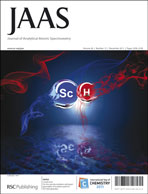Inductively coupled plasma mass spectrometry for determination of total urinary protein with CdTequantum dots label
Abstract
In the present work, a novel methodology for sensitive quantification of human total urinary

- This article is part of the themed collection: Analytical Atomic Spectrometry in Biomedical Sciences

 Please wait while we load your content...
Please wait while we load your content...